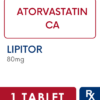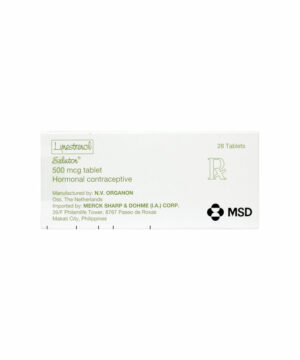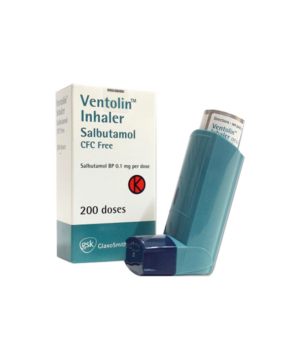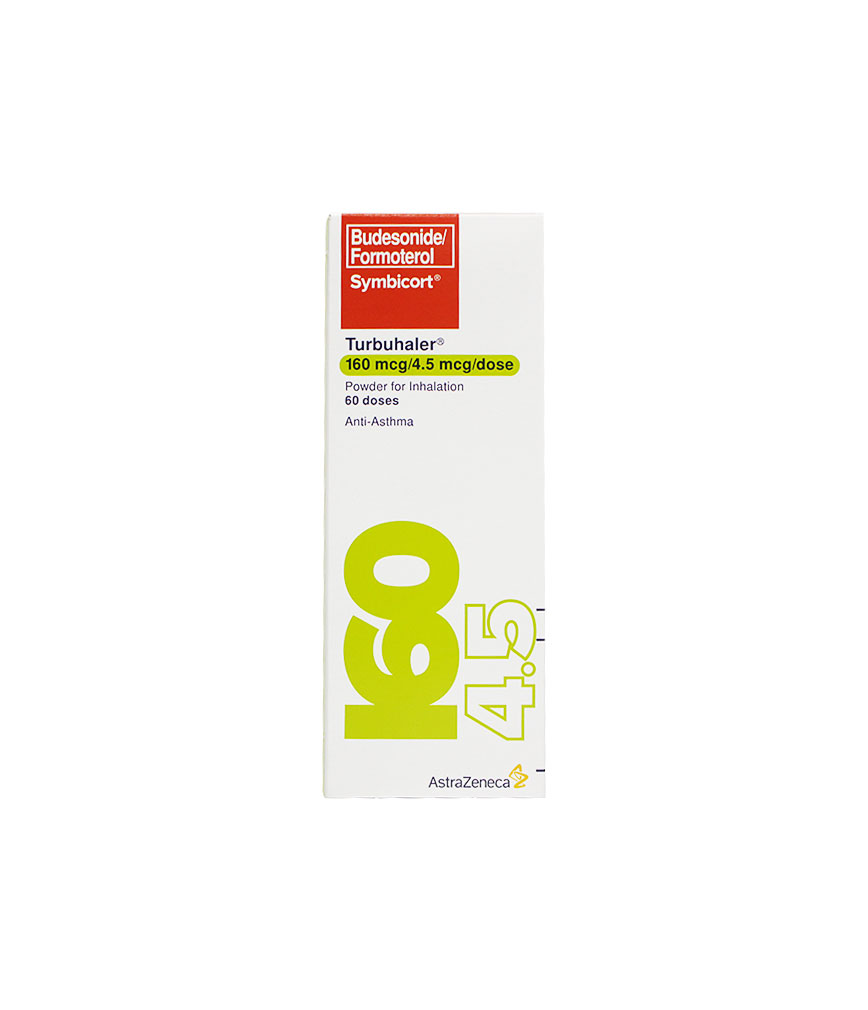Description
Buy Lipitor 80Mg Tablet at Rose Pharmacy Medicine Delivery
Description :
Lipitor 10: Each tablet contains atorvastatin calcium equivalent to 10 mg atorvastatin.
Lipitor 20 mg: Each tablet contains atorvastatin calcium equivalent to 20 mg atorvastatin.
Lipitor 40 mg: Each tablet contains atorvastatin calcium equivalent to 40 mg atorvastatin.
Lipitor 80 mg: Each tablet contains atorvastatin calcium equivalent to 80 mg atorvastatin.
Lipitor is a white, elliptical film coated tablet containing atorvastatin calcium. Atorvastatin calcium is a synthetic lipid-lowering agent, which is an inhibitor of 3-hydroxy-3-methylglutaryl-coenzyme A (HMG-CoA) reductase. This enzyme catalyzes the conversion of HMG-CoA to mevalonate, an early and rate-limiting step in cholesterol biosynthesis.
The empirical formula of atorvastatin calcium is (C33H34FN2O5)2Ca?3H2O and its molecular weight is 1209.42.
Atorvastatin calcium is a white to off-white crystalline powder, practically insoluble in aqueous solutions of pH 4 and below. It is very slightly soluble in distilled water, pH 7.4 phosphate buffer, and acetonitrile; slightly soluble in ethanol; and freely soluble in methanol.
Administration :
May be taken with or without food.
Contraindications :
Atorvastatin is indicated as an adjunct to diet for the treatment of patients with elevated total cholesterol (total-C), low density lipoprotein cholesterol (LDL-C), apolipoprotein B (apo B), and triglycerides (TG) and to increase high density lipoprotein cholesterol (HDL-C) in patients with primary hypercholesterolemia (heterozygous familial and non-familial hypercholesterolemia), combined (mixed) hyperlipidemia (Fredrickson Types IIa and IIb), elevated serum TGlevels (Fredrickson Type IV), and for patients with dysbetalipoproteinemia (Fredrickson Type III) who do not respond adequately to diet.
Atorvastatin is also indicated for the reduction of total-C and LDL-C in patients with homozygous familial hypercholesterolemia.
Prevention of Cardiovascular Complications: In patients without clinically evident cardiovascular disease (CVD), and with or without dyslipidemia, but with multiple risk factors for coronary heart disease (CHD), such as smoking, hypertension, diabetes, low HDL-C, or a family history of early CHD, atorvastatin is indicated to: Reduce the risk of fatal CHD and non-fatal myocardial infarction (MI); reduce the risk of stroke; reduce the risk of revascularization procedures and angina pectoris.
In patients with clinically evident CHD, atorvastatin is indicated to: Reduce the risk of non-fatal MI; reduce the risk of fatal and non-fatal stroke; reduce the risk for revascularization procedures; reduce the risk of hospitalization for congestive heart failure (CHF); reduce the risk of angina.
As adjunct to lifestyle changes, such as proper diet and exercise, intensive atorvastatin treatment has been shown to halt the progression of atherosclerosis (total atheroma or plaque volume) in patients with coronary artery disease and other individuals who are at high risk for cardiovascular disease.
Chronic Kidney Disease: In patients with diabetes with moderately decreased eGFR, Atorvastatin is indicated to reduce the risk for cardiovascular disease.
In patients with clinically evident coronary heart disease and CKD not requiring dialysis, atorvastatin is indicated to reduce the risk of major cardiovascular events including stroke.
In patients with clinically evident coronary heart disease and/or diabetes with microalbuminuria, atorvastatin is indicated to reduce the rate of GFR decline and progression of CKD.
Pediatric Patients (10-17 Years of Age): Atorvastatin is indicated as an adjunct to diet to reduce total-C, LDL-C, and apo B levels in boys and post-menarchal girls, 10 to 17 years of age, with heterozygous familial hyperchlolesterolemia if, after an adequate trial of diet therapy, the following findings are present: LDL-C remains =190 mg/dL or, LDL-C remains =160 mg/dL and there is a positive family history of premature CVD or, two or more other CVD risk factors are present in the pediatric patient.
Special Precautions:
Hepatic Effects: As with other lipid-lowering agents of the same class, moderate (>3 x ULN) elevations of serum transaminases have been reported following therapy with atorvastatin. Liver function was monitored during pre-marketing as well as post-marketing clinical studies of atorvastatin at doses of 10 mg, 20 mg, 40 mg and 80 mg.
Persistent increases in serum transaminases (>3 x ULN on two or more occasions) occurred in 0.7% of patients who received atorvastatin in these clinical trials. The incidence of these abnormalities was 0.2%, 0.2%, 0.6%, and 2.3% for the 10 mg, 20 mg, 40 mg and 80 mg doses respectively. Increases were generally not associated with jaundice or other clinical signs or symptoms. When the dosage of atorvastatin was reduced, or drug treatment interrupted or discontinued, transaminase levels returned to pre-treatment levels. Most patients continued treatment on a reduced dose of atorvastatin without sequelae.
Liver function tests should be performed before the initiation of treatment and periodically thereafter. Patients who develop any signs or symptoms suggesting liver injury should have liver function tests performed. Patients who develop increased transaminase levels should be monitored until the abnormality(ies) resolve(s). Should an increase in ALT or AST of >3 x ULN persist, reduction of dose or withdrawal of atorvastatin is recommended. Atorvastatin can cause an elevation in transaminases (see Adverse Reactions).
Atorvastatin should be used with caution in patients who consume substantial quantities of alcohol and/or have a history of liver disease. Active liver disease or unexplained persistent transaminase elevations are contraindications to the use of atorvastatin (see Contraindications).
Skeletal Muscle Effects: Myalgia has been reported in atorvastatin-treated patients (see Adverse Reactions). Myopathy, defined as muscle ache or muscle weakness in conjunction with increases in creatine phosphokinase (CPK) values >10 x ULN, should be considered in any patient with diffuse myalgias, muscle tenderness or weakness, and/or marked elevation of CPK. Patients should be advised to promptly report unexplained muscle pain, tenderness or weakness, particularly if accompanied by malaise or fever. Atorvastatin therapy should be discontinued if markedly elevated CPK levels occur or if myopathy is diagnosed or suspected. The risk of myopathy during treatment with drugs in this class is increased with concurrent administration of cyclosporine, fibric acid derivatives, erythromycin, niacin, azole antifungals, colchicines, telaprevir, boceprevir or the combination of tipranavir/ritonavir.
Many of these drugs inhibit cytochrome P450 3A4 (CYP 3A4) metabolism and/or drug transport. CYP 3A4 is the primary hepatic isozyme known to be involved in the biotransformation of atorvastatin. Physicians considering combined therapy with atorvastatin and fibric acid derivatives, erythromycin, immunosuppressive drugs, azole antifungals, or lipid-modifying doses of niacin should carefully weigh the potential benefits and risks and should carefully monitor patients for any signs and symptoms of muscle pain, tenderness, or weakness, particularly during the initial months of therapy and during any periods of upward dosage titration of either drug. Therefore, lower starting and maintenance doses of atorvastatin should also be considered when taken concomitantly with the aforementioned drugs. Temporary suspension of atorvastatin may be appropriate during fusidic acid therapy (see Interactions). Periodic CPK determinations may be considered in such situations, but there is no assurance that such monitoring will prevent the occurrence of severe myopathy. Atorvastatin may cause an elevation of CPK (see Adverse Reactions).
As with other drugs in this class, rare cases of rhabdomyolysis with acute renal failure secondary to myoglobinuria, have been reported. A history of renal impairment may be a risk factor for the development of rhabdomyolysis. Such patients merit closer monitoring for skeletal muscle effects. Atorvastatin therapy should be temporarily withheld or discontinued in any patient with an acute, serious condition suggestive of a myopathy or with a risk factor predisposing to the development of renal failure secondary to rhabdomyolysis, (e.g., severe acute infection; hypotension; major surgery; trauma; severe metabolic, endocrine, and electrolyte disorders; and uncontrolled seizures).
Hemorrhagic Stroke: A post-hoc analysis of a clinical study in 4731 patients without CHD who had a stroke or transient ischemic attack (TIA) within the preceding 6 months and were initiated on atorvastatin 80 mg revealed a higher incidence of hemorrhagic stroke in the atorvastatin 80 mg group compared to placebo (55 atorvastatin vs. 33 placebo). Patients with hemorrhagic stroke on entry appeared to be at increased risk for recurrent hemorrhagic stroke (7 atorvastatin vs. 2 placebo). However, in patients treated with atorvastatin 80 mg there were fewer strokes of any type (265 vs. 311) and fewer CHD events (123 vs. 204) (see Pharmacology: Pharmacodynamics under Actions).
Endocrine Function: Increases in hemoglobin A1c (HbA1c) and fasting serum glucose levels have been reported with 3-hydroxy-3-methylglutaryl-coenzyme A (HMG-COA) reductase inhibitors, including atorvastatin. The risk of hyperglycemia, however, is outweighed by the reduction in vascular risk with statins.
Effects on Ability to Drive and Use Machines: None known.














Reviews
There are no reviews yet.